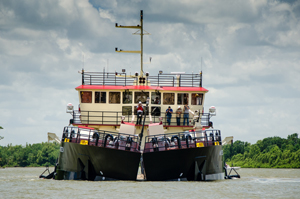Throughout history, shifting dirt from one place to another has consumed much of man’s energy and intelligence, resulting in ingenious, sometimes cruel, and often inventive solutions to the problem of moving huge quantities of material. The U.S. Army Corps of Engineers moves a lot of dirt, and it has designed a new dredge with which to do it.
Murden, named in honor of the late William R. Murden, formerly in charge of the Corps’ dredging operations, is a 156-foot by 35-foot split-hull hopper dredge with a draft of five feet, designed to work the shallow inlets, rivers and marinas on the Gulf and Atlantic coasts.
“This is the first split-hull hopper dredge specifically designed for the Corps,” said Matt Newborn, a naval architect with the Corps’ Marine Design Center (MDC) in Philadelphia and its representative at Conrad Industries in Morgan City, La., where the dredge was built. The center oversaw the project, contracting with Jensen Maritime Consultants, a Crowley Maritime company based in Seattle, for the principal design, with shipyard design support from Bristol Harbor Group of Bristol, R.I.
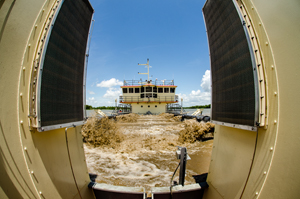 |
|
Most mariners would be horrified to see daylight through the hull of their vessel, but not the crew of a split-hull dredge. |
It’s no surprise that Murden resembles Currituck (Professional Mariner issue #71, April/May 2003), which began life in 1974 as a split-hull hopper barge. Currituck worked in tandem with a side-casting dredge that shot spoil into its hopper through a pipe. In 1977 it was converted to a hopper dredge, capable of dredging and transporting its own mud. “Murden is essentially a bigger, modernized and updated version of Currituck,” said Newborn.
“One of the things the Corps does regarding design is that it always has something it wants to replace,” said Johan Sperling, vice president at Jensen Maritime. “And they usually transfer their crew from the old boat to the new boat. So the crew and the operators were very much involved. They wanted something very much like their old dredge.”
Sperling and his colleagues spent a few days on Currituck during pre-design, observing what it did, how it did it, where it did it and under what conditions it was working. “We got started off on a very good foot by having lots of information on what they wanted,” he said. “They didn’t want to venture out and get too complex. They wanted it simple.”
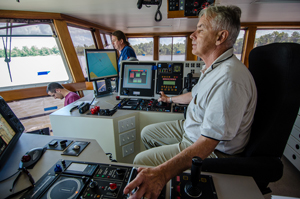 |
|
Capt. George Loveless at the controls on the split-bridge console that sits above the dragtender’s station. |
Even so, Sperling said, design continued for a year and a half, involving several trips between Seattle and Philadelphia. Not many split-hull dredges have been built, he said.
“A lot of what you see in the final boat is the result of the Corps being very specific about what they wanted so that all of the crews could rotate smoothly,” said Sperling. “That’s the Corps in a nutshell. They don’t go out and get the newest, sexiest and fanciest things they can find. They try to get things that they can work on themselves for years.”
Murden’s draft is not as shallow as a side-caster dredge’s, but it can move spoil to a specific site such as a beach that needs replenishment. On a side-caster, the draft remains constant because the dredge is shooting the material aside as fast as it is pumping it up from the bottom, but a split-hull hopper dredge pumps bottom slurry into its hopper, increasing its draft as it takes on more spoil. The hopper is made up of two hulls pivoting on pins, driven by hydraulic rams. At the spoil site, the hulls are opened and the material dropped between them.
“The side-casting system works well in shallow water, three and a half to four feet,” said Murden’s first mate, Barry Stull. “They get in there and work their way through. The split hull sits deeper in the water as it goes. We have a five-foot draft, but we need a couple of feet below the hull to get started. So we try to get on it at high tide and open it up as much as we can initially. The split hull also works better both ways in a current.”
Cargo capacity drives design in the transport industry, and it is no different in dredging. Currituck’s hopper holds 315 cubic yards; Murden, at 512 cubic yards, makes a bigger pile of mud.
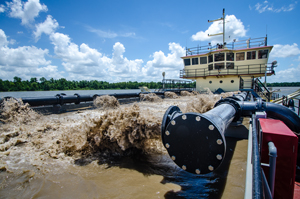 |
Murden’s first job was in Florida, dredging Clearwater Pass and its connecting channels. The boat then planned to work its way up the Atlantic coast to its home base in Wilmington, N.C.
“On that first project in Clearwater we don’t want to be testing and learning the equipment on the job,” said Capt. George Loveless, who in June was maneuvering Murden back and forth in Stouts Pass, dredging a rectangle of bottom mud from Louisiana’s Atchafalaya River. The site — a “box,” in dredging lingo — was being used for sea trials and testing the dredging equipment.
Loveless, at the helm in the dredge operator’s station, was making a series of 13-minute cuts, with Murden’s drag heads working at a depth of 11 feet, keeping the vessel on track and supervising Newborn and Stull. The pair were in the dragtender’s station, a bay window affair forward of, and lower than, the dredge operator’s station. Their primary concern was calibrating the equipment and operating the dredge pumps, raising and lowering the drag heads and dump controls.
From his seat between the two sides of the split console, Loveless kept track of the dredge’s position and progress in the box on a monitor fed by Hypack’s Dredgepack navigational and positioning software. Dredgepack gives GPS information, and real-time tidal data allow the operator to keep the drag heads a consistent distance from the bottom.
Keeping them at the correct height is important. Over-dredging can result in punctured pipelines and the destruction of sea grass, nesting areas, clam beds and the like.
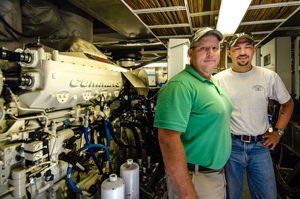 |
|
Chief Engineer David Cribbs (left) and Assistant Engineer John Crabtree with one of the two Cummins QSK 19-M 760-hp diesels. |
Stull explained that the best use of a split-hull hopper dredge is when the mud being dredged is needed elsewhere — “for example, from a channel such as a marina entrance that needs deepening to a beach that needs re-nourishment.”
That’s not unusual along the Gulf and Atlantic coasts, where digging out a channel can build up a nearby beach. As it happens, however, the Clearwater project doesn’t qualify. “Sometimes the sand dredged from inshore projects doesn’t measure up to the standards of pure sand required for a beach,” said Loveless.
A stem-to-stern tour of Murden reveals an efficient layout, jam-packed with equipment that, with few exceptions, is mirrored in or on each hull. On the bow are two bow thruster and anchor access hatches and two Hawboldt Industries anchor windlasses. Forward of the hopper are two CO2 cabinets, two exhaust stacks, two hull-access hatches and a small Hydra-Pro 2-ton deck crane located on the port side.
Next comes the hopper, operated by hydraulic rams that rotate pins on the center line, fore and aft, for opening the hulls.
A discharge pipe with six discharge nozzles lines each side of the hopper. The flange diameter of each nozzle can be changed by attaching a reduction plate to control the amount of material discharged. Changing the plate diameter allows the operator to favor the load forward or aft in the hopper, adjusting the draft of the dredge to correspond to the contour of the bottom at the spoil site.
 |
Each hull has a 25.5-foot drag arm that is raised or lowered by a Coastal Marine Equipment davit and winch. The drag arms have a drag head that takes in spoil pumped up through a pipe into the discharge pipe and through the nozzles into the hopper.
Each hull contains a dredge pump compartment housing a Cummins QSM 11-DM 250-kW generator powering a 100-hp Teco variable speed electric motor with an Allen-Bradley variable frequency drive and a Lufkin 4.7:1 reduction gear, driving a Mobile Pulley 10-inch Triathlon dredge pump.
Another compartment in each hull contains a BOC water hydraulic system that operates the cylinders and rams for opening and closing the hull. The system consists of a water reservoir, manifold and high-pressure intensifier. The intensifier increases the pressure when closed, to lock down the hulls.
“This is where it all happens,” said Newborn. “The water hydraulic system is used for operating the hopper latch and the hopper splitting cylinder. It’s self-contained and self-maintaining and is rugged and durable. The system operates on water, at 1,200 psi, and uses non-toxic antifreeze. So issues associated with hydraulic oil leaking from the hull rams are eliminated.”
Back on deck, aft of the hopper, the house is compact and comprises a galley, head, workspace and computer room. Murden, like Currituck, is a day boat working in shallow water and within sight of shore facilities. To keep the draft low and the boat light, the house is small, with no accommodations that would add weight. The house is also made of aluminum, unlike the hulls, which are steel.
The engine room sits behind the house at the stern and contains two 760-hp Cummins QSK 19-M diesels and ZF/HRP 4111 azimuthing stern drives with 2050 gears. Holland Rudder Propeller, a ZF company since 2009, also supplied the propulsion and steering controls for the drives and the Wesmar 100-hp bow thrusters. The stern drives pivot with the hull and can be adjusted up or down when the dredge is working in the shallows.
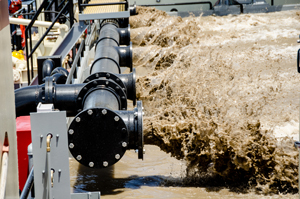 |
Behind the bridge, the upper aft deck should win an award for equipment-to-space ratio. Jammed onto the deck is a Lemoine HVAC system, a 58-kW Cummins emergency generator, an emergency switchboard and an aluminum six-man rescue boat supplied by Fast RSQ, a subsidiary of Ned-Deck Marine, the Netherlands-based company that supplied the boat’s davit system.
With so much equipment occupying so little deck space surrounding the large hopper, multiple construction change orders were inevitable. Newborn claimed over 100 such changes and adjustments were made at the Conrad yard during construction.
“Most of the on-site modifications were a response to the crew’s input and MDC input,” he said. “This boat has all the bells and whistles, and many of the modifications are to increase the crew-friendly aspect, especially regarding maintenance.”
Modifications included converting the bolted-down hatch covers to lift-hatch covers and increasing the opening size to 28-inch squares, for easier and safer access and egress. “And we rerouted the water hydraulic system hoses from below the waterline, where we’d need a diver to get at them, to on deck,” said Newborn. The bow thruster and anchor access hatches were also enlarged, to three feet.
“I’ve got to say that this was one of my most interesting and fun projects working at Jensen,” said Sperling. “Working with the Corps was very interesting. We learned a lot from them and I hope we taught them a few things, as well. It was a true partnership.”
The dredge-operating feasibility of a split-hull hopper dredge has been proven by Currituck in its 35 years of service. But the evolution of technology and the advent of sophisticated software that improved the dredging process have been joined in Murden with concern for the environment, as exemplified by the Tier II engines and the water hydraulic system for operating the split-hull mechanism. But can they handle turtles?
According to Loveless, the answer is yes. Murden uses a type of drag head designed by North Carolina’s Eagle Island Repair Yard for the dredge Merritt in the 60s. The boxy-looking device received the name Fry after it was tested in the late 90s on a dredge of that name to determine whether turtles could be sucked through it (Murden is the vessel replacing Fry).
“Fortunately it was found to be safe to turtles,” said Loveless. “Which means we are able to conduct year-around operations.”

